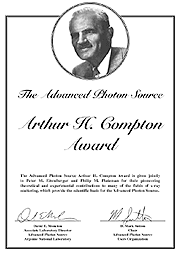ARGONNE, Ill. (May 7, 2007) — The Department of Energy's Advanced Photon Source (APS) and the APS Users Organization announced that the 2007 Arthur H. Compton Award was be presented jointly to Andrzej Joachimiak and Gerold Rosenbaum of Argonne National Laboratory for pioneering advances and leadership that helped to establish the APS as a premier location worldwide for protein crystallography research.
"Andrzej and Gerd were nominated for the Compton Award because of their individual, key contributions to protein crystallography research at the APS. The award underscores the worldwide stature of protein crystallography conducted at the APS and the importance of this field of research," said Murray Gibson, Argonne associate laboratory director for scientific user facilities. "It is a reflection of the quality of their work, dedication and the major role they both play in protein structure determination."
Andrzej Joachimiak is recognized both for his talents as a prolific crystallographer and methodological innovator working with difficult structures. He has been instrumental in establishing structural genomics as a part of modern biology and serves as director of both the Structural Biology Center and the Midwest Center for Structural Genomics, each within the Biosciences Division at Argonne.
Gerold Rosenbaum is recognized for his pioneering demonstration in 1970 that synchrotron radiation could be a source for biological X-ray diffraction as well as his innovative designs, that have set the world standard for biological diffraction. Currently Rosenbaum is a senior beamline scientist at the Southeast Regional Collaborative Access Team, operated at the APS by the University of Georgia, where he holds an appointment with the Department of Biochemistry and Molecular Biology.
The award was presented on Monday, May 7, at the first science session of 2007 Users Week at Argonne.
The Arthur H. Compton award was established in 1995 by the APS Users Organization to recognize an important scientific or technical accomplishment at, or beneficial to, the Advanced Photon Source.
Compton was an American physicist who won the Nobel Prize for Physics in 1927 for discovering and explaining changes in x-ray wavelengths resulting from x-ray collisions with electrons, the so-called Compton effect. This important discovery in 1922 confirmed the dual nature (wave and particle) of electromagnetic radiation.
The nation's first national laboratory, Argonne National Laboratory conducts basic and applied scientific research across a wide spectrum of disciplines, ranging from high-energy physics to climatology and biotechnology. Since 1990, Argonne has worked with more than 600 companies and numerous federal agencies and other organizations to help advance America's scientific leadership and prepare the nation for the future. Argonne is managed by UChicago Argonne, LLC for the U.S. Department of Energy's Office of Science.
For more information, please contact Eleanor Taylor (630/252-5565 or [email protected]) at Argonne.
Argonne is a U.S. Department of Energy laboratory managed by UChicago Argonne, LLC

